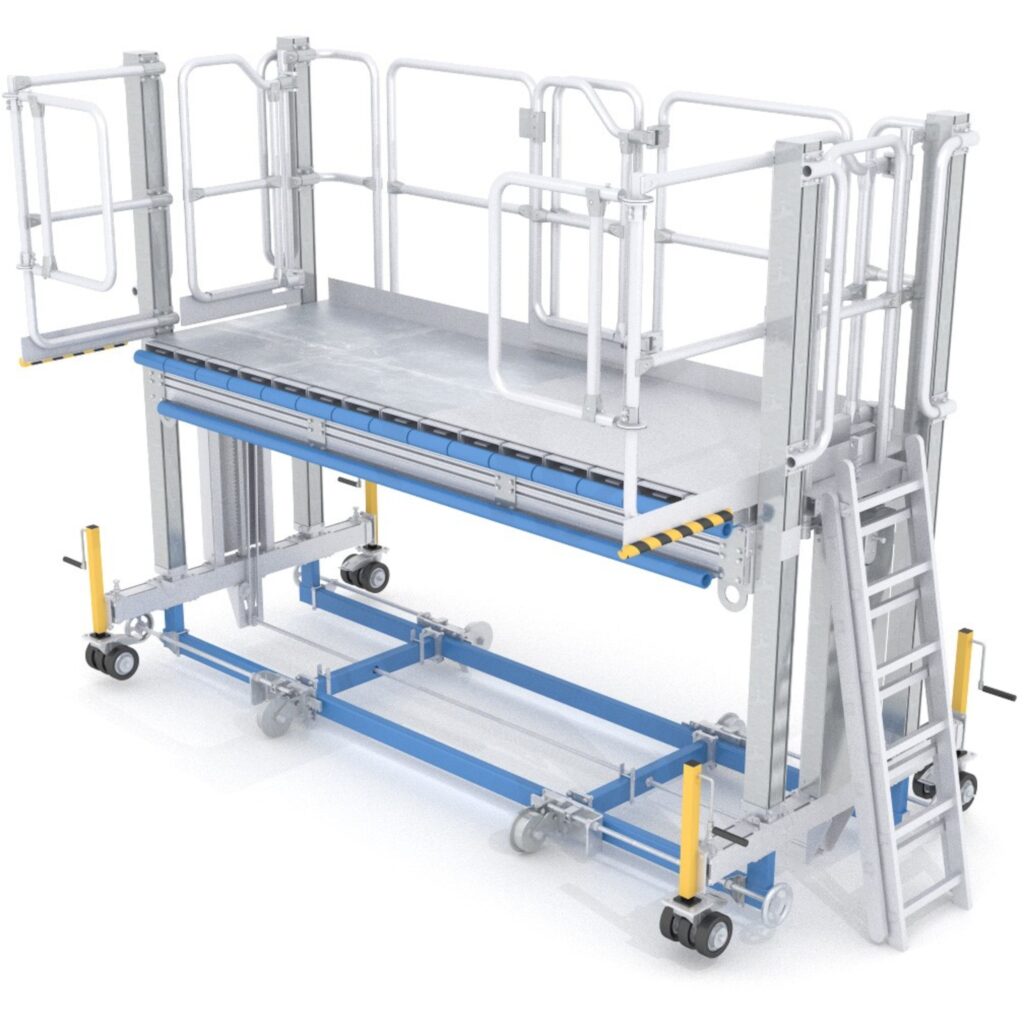
The term “work platform” can encompass a diverse range of structures, each serving a distinct purpose in facilitating efficient and safe work across various industries. In this article, we’ll delve into the world of work platforms, exploring their different types, applications, and essential safety considerations.
Unveiling the Variety: Types of Work Platforms
- Scaffolding: The classic image of construction sites often includes towering scaffolding, providing workers with stable platforms for reaching high areas. These temporary structures come in various configurations, such as supported scaffolds, suspended scaffolds, and mobile scaffolds, each suited for specific tasks.
- Aerial Work Platforms (AWPs): Also known as boom lifts or cherry pickers, AWPs offer elevated workspaces accessible through telescopic booms or scissor lifts. They excel in providing maneuverability and precise positioning for tasks like window cleaning, maintenance, and event setup.
- Mobile Work Platforms: Encompassing a broader range of structures, mobile work platforms include step ladders, workstations, and rolling platforms. These versatile solutions provide elevated work surfaces for smaller tasks or uneven terrain, often favored for painting, electrical work, and light construction.
- Modular Work Platforms: Offering flexibility and scalability, modular work platforms consist of interconnected components that can be configured to adapt to diverse workspaces. These platforms are commonly used in industrial settings, event production, and film sets.
Beyond Construction: Exploring Diverse Applications
While construction remains a primary domain for work platforms, their applications extend far beyond. Here are some intriguing examples:
- Entertainment: Concert stages, lighting rigs, and even pyrotechnic displays often rely on work platforms for safe and efficient setup and operation.
- Emergency Services: Firefighters utilize specialized aerial platforms for rescues and high-angle operations, while emergency medical technicians might use mobile platforms to reach injured individuals in challenging locations.
- Manufacturing: From assembling complex machinery to maintaining production lines, various industries leverage work platforms for safe access to elevated workstations.
- Cleaning and Maintenance: From skyscrapers to wind turbines, specialized work platforms enable efficient cleaning and maintenance of structures at various heights.
Safety First: Essential Considerations for Work Platform Use
Working at heights inherently carries risks, making safety paramount when using work platforms. Here are some crucial aspects to remember:
- Always follow manufacturer instructions and guidelines.
- Ensure proper training and certification for operators.
- Conduct thorough pre-use inspections of the platform.
- Utilize fall protection equipment like harnesses and lanyards.
- Maintain awareness of weather conditions and weight limitations.
By understanding the different types of work platforms, their diverse applications, and prioritizing safety practices, these valuable tools can empower individuals and industries to work efficiently and productively while prioritizing well-being.
I hope this comprehensive article provides valuable insights into the world of work platforms!
Work Platform FAQs: Your Guide to Safe and Efficient Work at Heights
What is a work platform?
A work platform is any structure designed to provide a stable and elevated working surface for various tasks. They come in numerous types, from simple step ladders to complex modular systems, catering to diverse applications across industries.
What are the different types of work platforms?
- Scaffolding: Temporary structures typically used in construction for reaching high areas.
- Aerial Work Platforms (AWPs): Boom lifts or cherry pickers offering elevated access through telescopic or scissor mechanisms.
- Mobile Work Platforms: Step ladders, workstations, and rolling platforms for smaller tasks or uneven terrain.
- Modular Work Platforms: Adaptable and scalable structures commonly used in industrial settings, events, and film sets.
What are the main applications of work platforms?
- Construction: From building facades to roof repairs, work platforms provide safe access to elevated areas.
- Entertainment: Setting up stages, hanging lights, and managing pyrotechnics rely on work platforms for efficiency and safety.
- Emergency Services: Firefighters and medical personnel utilize specialized platforms for rescues, maintenance, and reaching injured individuals.
- Manufacturing: Assembling machinery, maintaining production lines, and accessing equipment benefit from work platforms.
- Cleaning and Maintenance: Work platforms enable efficient cleaning and maintenance of high-rise buildings, wind turbines, and other structures.
What are the key safety considerations when using work platforms?
- Training and Certification: Always ensure operators are trained and certified for the specific type of platform used.
- Pre-Use Inspections: Conduct thorough inspections to check for any damage or malfunctions before each use.
- Fall Protection: Utilize harnesses, lanyards, and guardrails to minimize fall risks.
- Weight Limits and Weather: Adhere to weight limitations and avoid using platforms in adverse weather conditions.
- Manufacturer Instructions: Always follow the manufacturer’s instructions and safety guidelines for proper use.
Where can I rent or purchase a work platform?
Numerous companies offer work platform rentals or sales, depending on your needs and budget. Research reputable firms in your area and inquire about specific needs and available options.
Do I need a permit to use a work platform?
Permit requirements may vary depending on your location and the type of platform used. Contact your local authorities to determine if permits are necessary for your work project.
